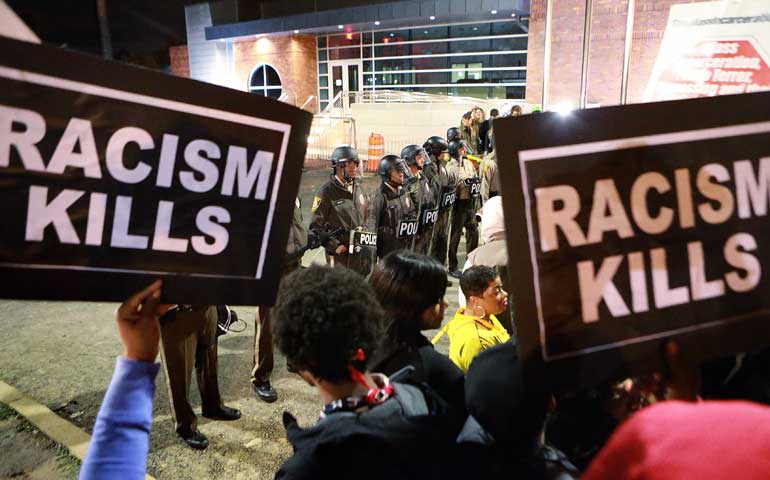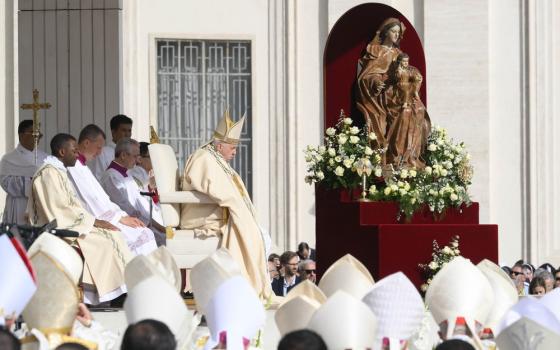
Protesters gather in front of the police station Oct. 11 in Ferguson, Mo. (AP Photo/St. Louis Post-Dispatch/Christian Gooden)
On an auditorium stage in front of 1,500 people, a preteen activist stood behind a podium nearly as tall as she was. "Don't get me wrong, I love [them]," she said, gesturing to the two dozen clergy, community leaders and national civil rights figures behind her. "But what most of these people do is they say how they feel and they say what's really good and how everyone feels and how motivated they are and what we should be doing -- but they don't do it."
The young speaker delivered this rebuke at the Oct. 12 Ferguson October Mass Meeting, the centerpiece of a weekend of events intended to focus local and national attention on the issues surrounding the fatal shooting of 18-year-old Michael Brown Jr., by Ferguson Police Officer Darren Wilson Aug. 9.
She is part of a new generation of civil rights activists facing very old problems.
The girl was not on the official program for what organizers had billed as a mass meeting "in the tradition of the civil rights movement." Speakers were to include Cornel West, the Rev. Jim Wallis, and activist and holocaust survivor Hedy Epstein, along with two dozen local clergy and community leaders. As the program of prayers, music and talks progressed, however, many in the crowd began to express discontent. Chants of "Let the youth speak!" spread.
The Rev. Traci Blackmon, emcee of the event, spoke with youth and organizers to come up with a new plan. She apologized to those who were asked to forgo their time at the podium, including Wallis. She said it was the right thing to do, however, because these youth had been leading the movement in Ferguson from the beginning.
After all, she said, echoing a popular protest chant, "this is what democracy looks like."
Ashley Yates, a young activist and a leader of the movement in Ferguson, also took the podium. "People take our anger and they try to make it violent, when the real violence is the AK-47s and the M16s that are pointed at us," Yates lamented to the audience. Violence is "when you see a sniper pop out of the top of a tank with a smile on his face, when all you have is your hands and your words and your anger," she said.
"I am OK with being angry," she continued. "If you can see a dead black body lying in the street for four and a half hours and that doesn't make you angry, then you lack humanity. ... When we neglect to see [our shared humanity], we end up where we are today."
"The chants that you are hearing are us saying 'See my humanity! See me for who I am.' "
Closing the evening, the Rev. Osagyefo Sekou summed up the importance of what had happened. "What you have witnessed tonight is a transition of leadership. New leaders have emerged."
This shift to new voices and new leadership is indicative of the movement in Ferguson, where activists are working to change the longstanding structural and societal inequalities they say led to Brown's death. Teens and young adults, young women and men of many faiths or none, have been at the core of the movement, and have challenged clergy and community leaders to join them more fully. The young activists contend that the established leaders call for action on the issues in Ferguson without engaging deeply themselves.
Activists here are connecting Brown's death with other police shootings of young African-American men in recent months, including Vonderrit Myers, another 18-year-old shot to death in south St. Louis, and John Crawford, 22, who was shot and killed in a Wal-Mart in Beavercreek, Ohio, when fellow shoppers and police thought the toy BB gun Crawford had picked up from a store shelf was a real gun. They also remember Eric Garner of New York City, who was killed by a police chokehold as they arrested him for selling untaxed cigarettes.
"We know it's not just isolated to Ferguson. We see all the other cases," Yates said on the television program Democracy Now. "And we've made grand efforts to get out to those cities and connect with those people, to let people know that this is not just a Ferguson issue, it's a nationwide issue of police brutality that has to stop."
In addition to these shootings, a broader source of protesters' anger is their perception of unjust policing of communities of color. The young black men she's worked with, said Trineka Greer of the organization PICO California, know that "there are streets in Ferguson if they're walking down or driving down, they're going to be subject to harassment and interrogation by the police." Greer said such action is "traumatic" when it is a longstanding situation.
This perception seems to be written in the data. According to 2013 numbers from the office of Missouri Attorney General Chris Koster, blacks in Missouri are 66 percent more likely than whites to be stopped, after accounting for population differences. Once stopped, blacks are twice as likely to be searched.
The most telling statistic, however, is that among those searched, whites are 30 percent more likely to be found in possession of contraband. (In Ferguson, blacks are 260 percent more likely to be stopped and 77 percent more likely to be searched. Whites are 57 percent more likely to be found with contraband.) The numbers seem to indicate that higher suspicion of blacks is unwarranted.
Many activists are also upset by the degree of public outcry against the looting in Ferguson compared to the outcry against the recent shootings of young black men. In their eyes, this indicates that the value of a black life is worth less than the value of property.
"I would rather these people take their anger out on property and products rather than on other people," Brittney Cooper of Rutgers University wrote for the website Salon in August. "I question a society that always sees the product of the provocation and never the provocation itself. I question a society that values property over black life."
To address these and other related issues, activists are seeking accountability and transparency from the government and police, the appointment of a special prosecutor for all police-involved shootings, reform of police department policies, and a means for civilian review of allegations of police misconduct.
In Ferguson and around the country, activists are employing a variety of tactics to campaign for these goals. Social media has played a crucial role in organizing and spreading the word about efforts ranging from talks and panel discussions to community events like a free books-and-breakfast giveaway. Activists have also brought their requests to government officials at city and county council meetings, and in one-on-one meetings.
The older generation and clergy have begun to participate in the Ferguson protests in larger numbers, especially as the announcement of a grand jury decision whether to indict officer Darren Wilson, who shot Brown, draws closer. On one notable night in late September, a group of protesters had gathered across the street from the Ferguson police station. A line of activists, mostly young people, stood in front of the gathering, prepared to risk arrest.
As officers told this group to leave or be arrested, Sekou moved in between the activists and officers. As he knelt and prayed in the street, he was joined by other clergy of various faiths. Though the whole group had knowingly risked arrest, Sekou was the only person arrested that night. He was released a few hours later after negotiations between protesters and Capt. Ron Johnson of the Ferguson police.
"We must choose sides. We cannot be lukewarm," Sekou said in an interview with the online magazine Medium. "Jesus clearly takes sides with the oppressed, and we must side with the youth, Mike Brown, and all of the oppressed."
[Robyn Haas is NCR web developer. Her email address is rhaas@ncronline.org.]


